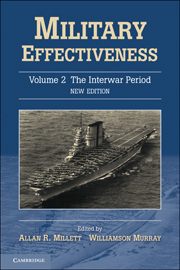Book contents
- Frontmatter
- Contents
- List of Contributors
- Introduction: Military Effectiveness Twenty Years After
- Maps
- 1 The Soviet Armed Forces in the Interwar Period
- 2 The French Armed Forces, 1918–40
- 3 The Military Effectiveness of the US Armed Forces, 1919–39
- 4 The British Armed Forces, 1918–39
- 5 Japanese Military Effectiveness: The Interwar Period
- 6 The Italian Armed Forces, 1918–40
- 7 German Military Effectiveness between 1919 and 1939
- 8 Military Effectiveness of Armed Forces in the Interwar Period, 1919–41: A Review
- Index
3 - The Military Effectiveness of the US Armed Forces, 1919–39
Published online by Cambridge University Press: 05 June 2012
- Frontmatter
- Contents
- List of Contributors
- Introduction: Military Effectiveness Twenty Years After
- Maps
- 1 The Soviet Armed Forces in the Interwar Period
- 2 The French Armed Forces, 1918–40
- 3 The Military Effectiveness of the US Armed Forces, 1919–39
- 4 The British Armed Forces, 1918–39
- 5 Japanese Military Effectiveness: The Interwar Period
- 6 The Italian Armed Forces, 1918–40
- 7 German Military Effectiveness between 1919 and 1939
- 8 Military Effectiveness of Armed Forces in the Interwar Period, 1919–41: A Review
- Index
Summary
Political Effectiveness
The US armed forces in the 1920s and 1930s were obliged to function in a political environment which made it extremely difficult, if not impossible, for those organizations to secure the financial, industrial, and human resources which they considered necessary to attain even the minimum level of military capability to carry out their anticipated wartime missions. A leading student of the history of the US Army even suggests that ‘the Army during the 1920s and early 1930s may have been less ready to function as a fighting force than at any time in its history. It lacked even the combat capacity that the Indian campaigns had forced on it during the nineteenth century and the pacification of the Philippines had required early in the twentieth century.’
The United States had traditionally avoided the maintenance of a large professional army. After 1898 it had created a large and powerful, although unbalanced, naval force, but by the beginning of the 1920s the complete destruction of one of the navy's most powerful potential adversaries (Germany) and close friendship with another (Britain), together with growing popular support for naval disarmament, had called the continued necessity for a large fleet into question.
With the dramatic rejection of the Versailles Peace Settlement by the Senate in 1919, the United States turned its back upon any involvement in international projects aimed at collective security. Efforts at disarmament were welcomed so long as they involved no political or military commitments.
- Type
- Chapter
- Information
- Military Effectiveness , pp. 70 - 97Publisher: Cambridge University PressPrint publication year: 2010



